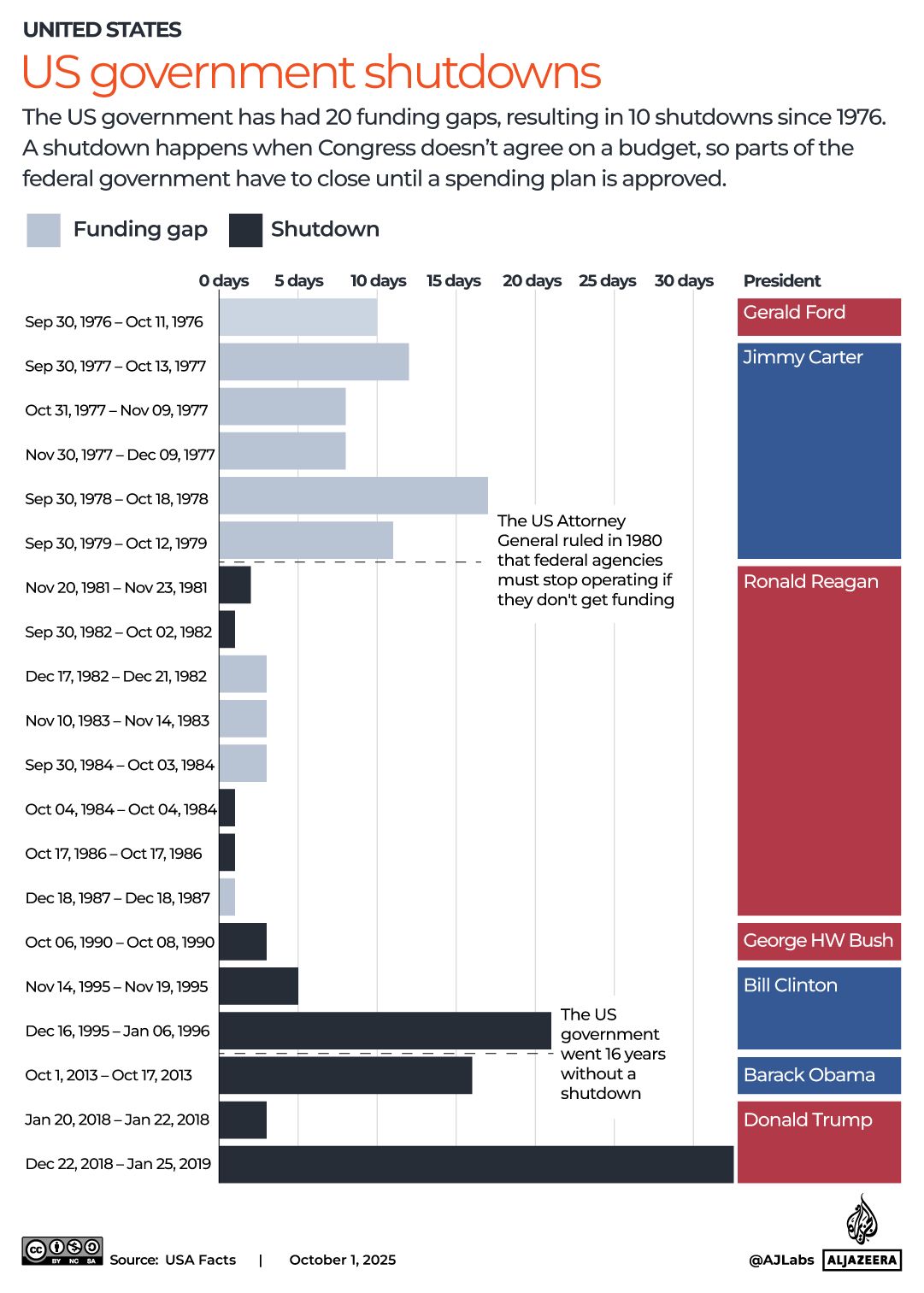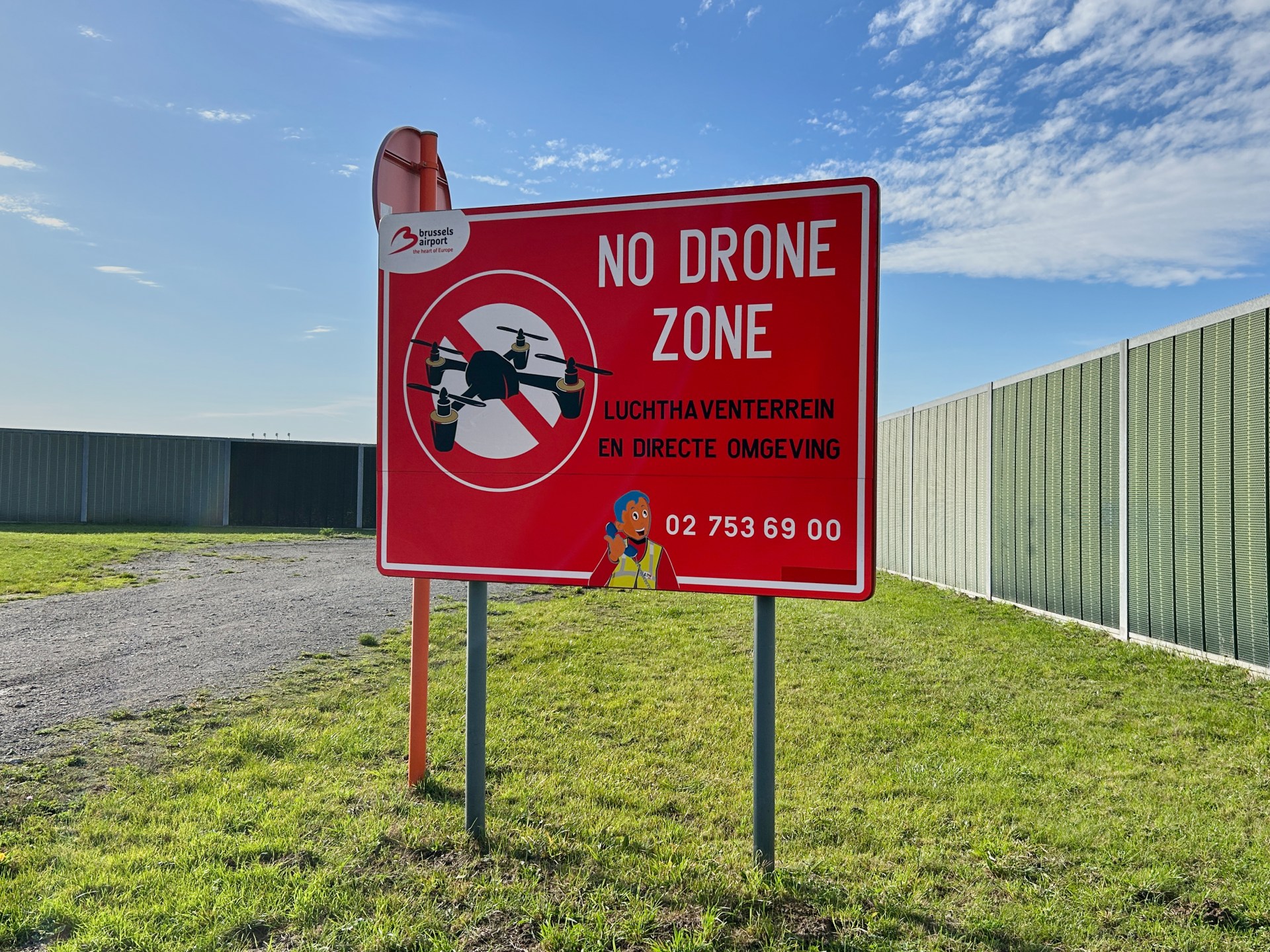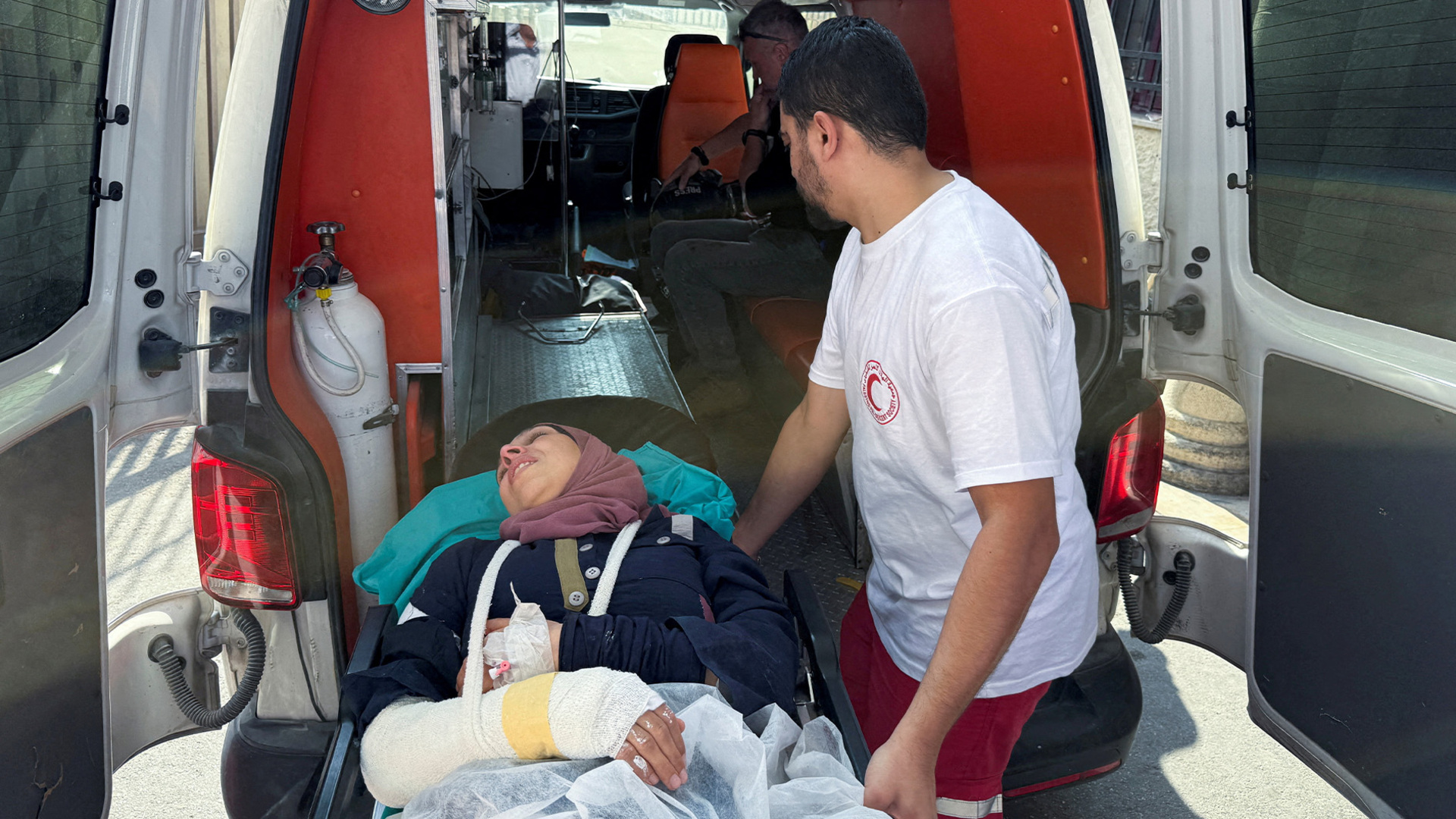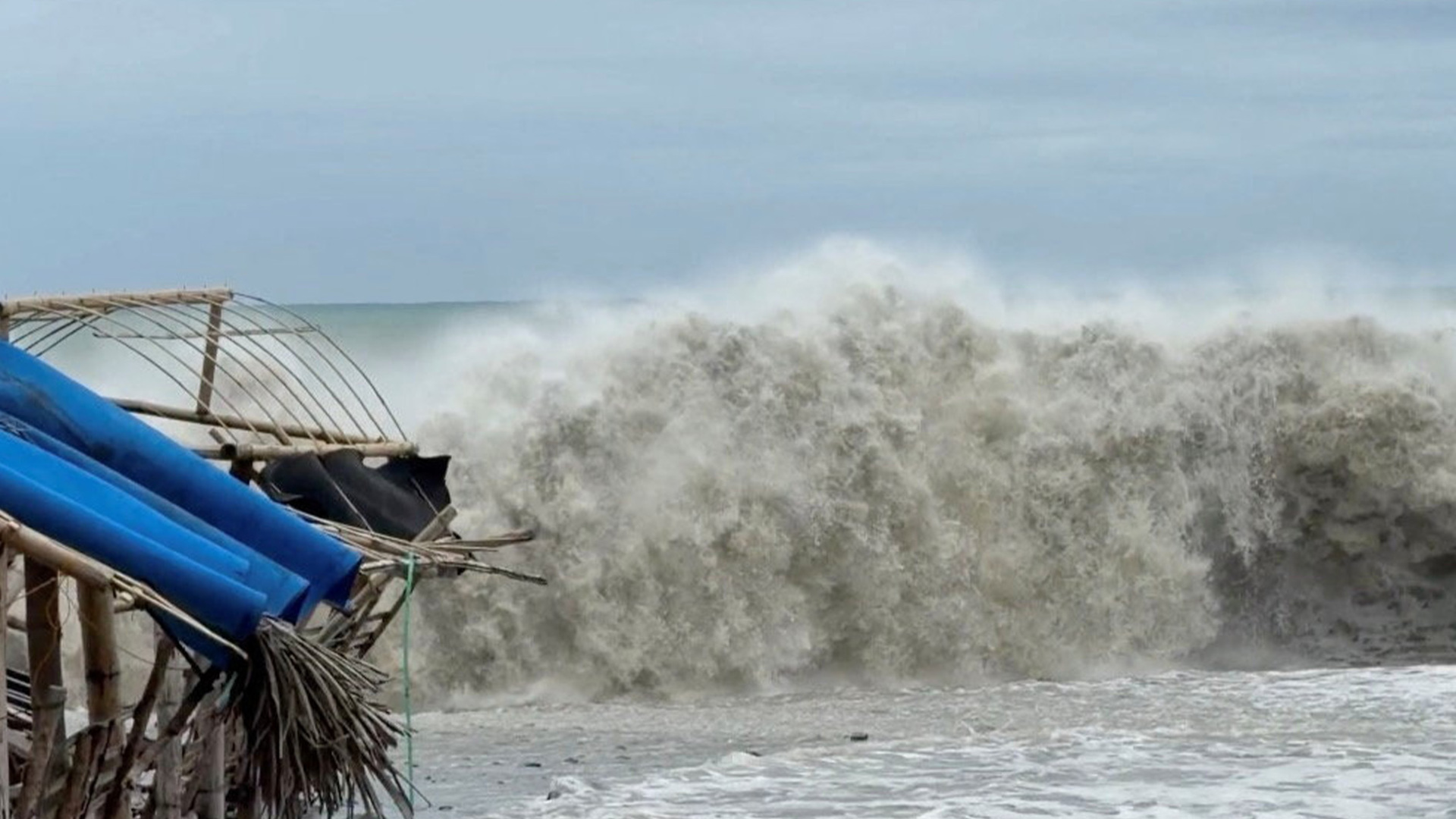As United States lawmakers fail to agree on a deal to end the government shutdown, around 750,000 federal employees have been furloughed, millions of Americans go without food assistance, and air travel is disrupted across the country.
The shutdown began on October 1, after opposing sides in the US Senate failed to agree on spending priorities, with Republicans rejecting a push by Democrats to protect healthcare and other social programmes.
Recommended Stories
list of 4 itemsend of list
Since then, both sides have failed to agree on 14 separate funding measures, delaying payment to hundreds of thousands of federal staff.
After 40 days, senators from both parties are working this weekend to try to end what has become the longest government shutdown in US history. But talks on Saturday showed little sign of breaking the impasse and securing long-term funding for key programmes.
On Friday, Democratic Senate leader Chuck Schumer offered Republicans a narrower version of an earlier Democratic proposal – a temporary extension of healthcare subsidies. Republicans rejected the offer, prolonging the record-breaking shutdown.
So what do we know about the shutdown, and how it has impacted Americans?
Flights disrupted
The shutdown has created major disruptions for the aviation industry, with staffing shortages among unpaid air traffic controllers.
More than 1,530 flights were cancelled across the US on Saturday, while thousands more were delayed as authorities ordered airports to reduce air traffic.
According to the flight tracking website FlightAware, Saturday’s cancellations marked an increase from 1,025 the previous day. The trend looks set to continue, with at least 1,000 cancellations logged for Sunday.
The Federal Aviation Administration (FAA) said staffing shortages were affecting 42 control towers and other facilities, leading to delays in at least a dozen major cities – including Atlanta, Newark, San Francisco, New York and Chicago.
The travel chaos could prove politically costly for lawmakers if disruptions persist, especially ahead of the holiday season. Reduced air traffic will also hit deliveries and shipping, since many commercial flights carry cargo alongside passengers.
The CEO of Elevate Aviation Group, Greg Raiff, recently warned that the economic impact would ripple outward. “This shutdown is going to affect everything from business travel to tourism,” he told the Associated Press.
“It’s going to hurt local tax revenues and city budgets – there’s a cascading effect from all this.”
Threat to food assistance
In recent weeks, US President Donald Trump has said he will only restore food aid once the government shutdown ends.
“SNAP BENEFITS, which increased by Billions and Billions of Dollars (MANY FOLD!) during Crooked Joe Biden’s disastrous term … will be given only when the Radical Left Democrats open up government,” he wrote earlier this week on Truth Social.
The US Supplemental Nutrition Assistance Program (SNAP), or food stamps, provides low-income Americans with roughly $8bn a month in grocery assistance. The average individual benefit is about $190 per month, while a household receives around $356.
Health insurance standoff
Democrats blame the shutdown on Republicans’ refusal to renew expiring healthcare subsidies under the Affordable Care Act (ACA). Talks stalled again on Saturday after Trump declared he would not compromise on the issue.
Democrats are pushing for a one-year extension of the ACA subsidies, which mainly help people without employer or government health coverage buy insurance. But with a 53–47 majority in the Senate, Republicans can block the proposal.
Trump intervened on Saturday via Truth Social, calling on Republican senators to redirect federal funds used for health insurance subsidies toward direct payments for individuals.
“I am recommending to Senate Republicans that the Hundreds of Billions of Dollars currently being sent to money sucking Insurance Companies … BE SENT DIRECTLY TO THE PEOPLE SO THAT THEY CAN PURCHASE THEIR OWN, MUCH BETTER, HEALTHCARE, and have money left over,” he said.
Roughly 24 million Americans currently benefit from the ACA subsidies. Analysts warn that premiums could double by 2026 if Congress allows them to expire.
Has this happened before?
This is not the first time Washington has faced such a standoff. The graphic below shows every US funding gap and government shutdown since 1976, including how long each lasted and under which administration it occurred.
The current federal budget process dates back to 1976. Since its creation, the government has experienced 20 funding gaps, leading to 10 shutdowns.
Prior to the 1980s, such funding lapses rarely caused shutdowns. Most federal agencies continued operating, expecting Congress to soon approve new funding.
That changed in 1980, when Attorney General Benjamin Civiletti issued legal opinions clarifying that, under federal law, agencies cannot spend money without congressional authorisation. Only essential functions (like air traffic control) were permitted to continue.
From 1982 onward, this interpretation has meant that funding gaps have more frequently triggered full or partial government shutdowns, lasting until Congress reaches a resolution.
What happens next?
No breakthrough was announced after the US Senate convened for a rare Saturday session. The chamber is now expected to reconvene at 1:30pm local time on Sunday.
Senate Majority Leader John Thune told reporters that the chamber will continue meeting until the government reopens. “There’s still only one path out – it’s a clean funding extension,” he said.
Some 1.3 million service members are now at risk of missing a paycheque, and that might put pressure on both sides to agree on a deal. Earlier this month, staff were paid after $8bn from military research and development funds were made available at the intervention of Trump.
But questions remain about whether the administration will resort to a similar procedure if the shutdown is prolonged. Senator Jeanne Shaheen of New Hampshire told reporters on Friday that Democrats “need another path forward”.
Shaheen and several moderate Democrats are floating a proposal that would temporarily fund certain departments – such as veterans’ services and food aid – while keeping the rest of the government open until December or early next year.
It’s understood that Shaheen’s plan would include a promise of a future vote on healthcare subsidies, but not a guaranteed extension. It remains unclear whether enough Democrats would support that compromise.
Thune, meanwhile, is reportedly considering a bipartisan version of the proposal. On Friday, he said he thinks the offer is an indication that Democrats are “feeling the heat … I guess you could characterise that as progress”.
Looking ahead, it remains unclear what Republicans might offer regarding healthcare.





